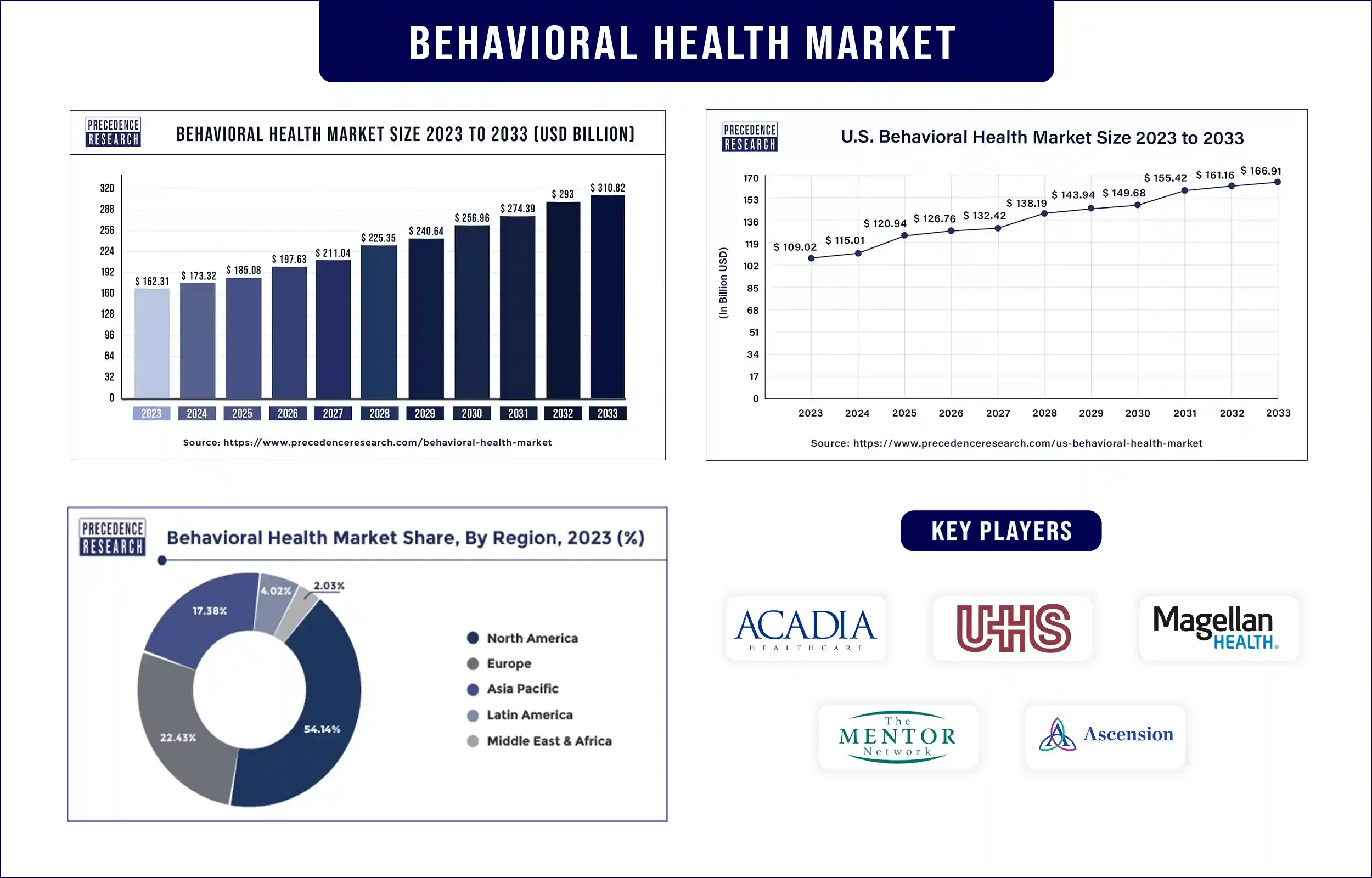Behavioral Health Market Revenue to Attain USD 310.82 Bn by 2033
Behavioral Health Market Revenue and Trends
The global behavioral health market revenue was valued at USD 173.32 billion in 2024 and is expected to attain around USD 310.82 billion by 2033, growing at a CAGR of 6.71% during the forecast period. The behavioral health market is driven by the rising awareness about mental health that boosts the demand for behavioral health services.

Market Overview
Behavioral health is a broad term that covers broad topics like an individual’s emotional, mental, and social well-being. This also includes substance use disorders like alcohol and drug addiction. The global behavioral health market is primarily driven by the rising prevalence of various mental health disorders and the growing geriatric population. It is observed that geriatric people are more prone to mental disorders as compared to adults. According to the World Health Organization (WHO), depression is a common mental disorder. Globally, around 3.8% of the population experience depression, including 5% of adults (4% among men and 6% among women), and 5.7% of adults older than 60 years.
The rising adoption of digital technologies across healthcare units is expected to drive the behavioral health market growth. The growing demand for home-based mental health services, especially among teens and children, is expected to significantly drive the growth of the market during the forecast period.
Highlights of the Behavioral Health Market Report
- Based on service type, the inpatient hospital treatment segment registered its dominance in 2023. The segmental dominance is attributed to the rising number of mental health cases, which require 24/7 care. However, inpatient hospital services provide 24/7 care, making them suitable to treat patients within a shorter period. Moreover, the rising rehabilitation programs under the guidance of physicians contributed to segmental growth.
- On the basis of disorder type, the depression & anxiety segment dominated the market in 2023. This is mainly due to the increasing instances of depression and anxiety across the globe, leading to a high demand for behavioral health services. On the other hand, the substance abuse disorder segment is expected to grow at a rapid pace in the coming years, owing to the increasing prevalence of drug abuse, especially among youngsters.
- Based on end-user, the outpatient clinics segment held the largest share of the market in 2023 due to their cost-effective services. These clinics provide diagnostic services, treatments, and rehabilitation to patients, reducing the need for hospitalization.
Market Trends
- Rising awareness of mental health: With the rising awareness of mental health among the population, the demand for behavioral health services, such as screening, diagnosis, and treatment, is increasing. In addition, people are becoming more aware of the symptoms, encouraging them to seek early intervention.
- Increasing cases of mental disorders: The rising cases of mental disorders led to the increased demand for their screening. According to the WHO, about 1 billion people suffer from mental disorders, including anxiety, depression, and substance abuse, each year, resulting in an increase in the demand for behavioral health services.
- Government support: Governments are making efforts to spread awareness about mental health. This, in turn, encourages people to seek early care, boosting the market growth. Moreover, governments are introducing campaigns to make people aware of the availability of therapies.
Regional Insights
North America dominated the behavioral health market in 2023. This is mainly due to its well-established healthcare infrastructure. The improved access to mental healthcare services, increased awareness regarding mental health, and high healthcare expenditure bolstered the market in the region. Increasing incidences of drug and substance abuse disorders and the growing geriatric population in the U.S. contributed to regional market growth. The geriatric population in the U.S. is estimated to reach 90 million by 2050. Moreover, the rising number of reimbursement policies and insurance coverages for behavioral health services contributed to the region’s dominance.
Behavioral Health Market Coverage
| Report Attribute | Key Statistics |
| Market Revenue in 2024 | USD 173.32 Billion |
| Market Revenue by 2033 | USD 310.82 Billion |
| CAGR | 6.71% from 2024 to 2033 |
| Quantitative Units | Revenue in USD million/billion, Volume in units |
| Largest Market | North America |
| Base Year | 2023 |
| Regions Covered | North America, Europe, Asia-Pacific, Latin America, and Middle East & Africa |
Market News
- In October 2024, the University of Rhode Island College of Health Sciences introduced a new Mental and Behavioral Health Counseling master's program to prepare students to become Licensed Mental Health Counselors.
- In October 2024, Arbital Health and Quartet Health partnered to enhance value-based mental healthcare through Quartet's Whole Health program, aiming to lower costs and improve outcomes for patients with serious mental illness.
- In October 2024, Empatha secured a substantial capital raise to expand behavioral health services in workers' compensation, focusing on scaling operations, AI-powered care coordination, and improving patient outcomes.
Segments Covered in the Report
By Service Type
- Home-Based Treatment Services
- Outpatient Counselling
- Emergency Mental Health Services
- Inpatient Hospital Treatment
- Intensive Care Management
By Disorder Type
- Bipolar Disorder
- Anxiety Disorder
- Depression
- Post-Traumatic Stress Disorder
- Eating Disorder
- Substance Abuse Disorder
- Others
By End-Users
- Outpatient Clinics
- Hospitals
- Rehabilitation Centers
- Homecare Setting
Get this report to explore global market size, share, CAGR and trends, featuring detailed segmental analysis and an insightful competitive landscape overview@ https://www.precedenceresearch.com/checkout/1174
You can place an order or ask any questions, please feel free to contact at sales@precedenceresearch.com | +1 804 441 9344